TB NOTES

TB Notes 4, 2023
Dear Colleague,
Reflecting on 2023, I’m inspired by the continued commitment to eliminating tuberculosis (TB) our partners and TB program staff have demonstrated through another dynamic year. This issue of TB Notes for 2023 offers a summary of some of the highlights and accomplishments from Division of Tuberculosis Elimination (DTBE) this year, with a few highlights from this quarter noted below.
In November, CDC published Reported Tuberculosis in the United States, 2022, which shows that reported TB cases and incidence rates in the United States increased for the second year in a row but remained lower than levels reported prior to the COVID-19 pandemic. The number of reported TB cases and incidence rates appears to be gradually returning to prepandemic levels but concerns about pandemic-related disruptions to public health persist.
CDC continues to support the Uniting for Ukraine program to increase awareness about the TB screening and attestation requirements of people arriving from Ukraine. Partners can adapt resources and content to share information with people arriving from Ukraine and their sponsors.
The Tuberculosis Trials Consortium (TBTC) continues to innovate TB prevention and treatment through the new CRUSH-TB study, a unique collaboration of researchers from CDC and domestic and international partners.
This quarter, DTBE staff were able to connect with many of our TB partners through in-person and virtual regional TB conferences, research consortia meetings, and summits.
None of this work would be possible without the help of our partners. I look forward to working together in 2024 to continue our mission. Thank you for your continued partnership and commitment to TB elimination in the United States.
Best wishes for a happy and healthy new year!
Philip LoBue, MD, FACP, FCCP
Director
Division of Tuberculosis Elimination
National Center for HIV, Viral Hepatitis, STD, and TB Prevention
This year, DTBE would like to reflect on the research, innovation, resources, and world events that shaped another momentous year. Here is a look back at some TB highlights of 2023.
Think. Test. Treat TB
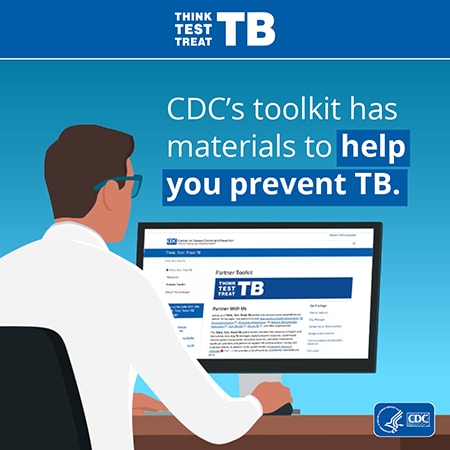
CDC expanded its Think. Test. Treat TB communications campaign to raise awareness about latent TB infection, risk, and the link between latent TB infection and TB disease among healthcare providers who serve populations at risk for TB. Since its launch, the campaign website has over 98,000 total page views and over 4,183 resource downloads. To date, 115,825 campaign resources have been ordered and shipped to partners. Materials are available free of charge for order via CDC-Info On Demand Publications (see ordering instructions).
World TB Day
On March 24, CDC recognized World TB Day, an annual event to commemorate the date in 1882 when Dr. Robert Koch announced his discovery of Mycobacterium tuberculosis, the bacillus that causes TB. CDC recognized 19 U.S. TB Elimination Champions who demonstrated health equity principles in their work to eliminate TB. Nominations for 2024 U.S. TB Champions will open in January 2024. Additional activities included a Dear Colleague Letter from CDC Director, Rochelle Walensky, MD, MPH, highlighting the importance of timely diagnoses of TB disease.
2023 National TB Conference
The 2023 National TB Conference (NTC) was held in Atlanta, Georgia, from June 12-15, 2023, in conjunction with the Association of Public Health Laboratories’ (APHL) 13th National Conference on Laboratory Aspects of TB. The theme of the 2023 NTC was “Partnership, Innovation and Equity.”
Uniting for Ukraine
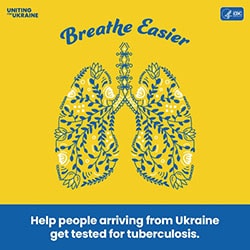
In September, CDC released TB resources to increase awareness about the TB screening and attestation requirements of the Uniting for Ukraine program. Resources are available in Ukrainian, Russian, and English and include a conversation guide, fact sheet, flyer, and poster. The CDC Uniting for Ukraine website has had over 23,000 page views and CDC distributed 9,000 print materials to partners.
UN General Assembly
In September, the United Nations General Assembly (UNGA) held the second high-level meeting on TB. The theme of the meeting was: “Advancing science, finance and innovation, and their benefits, to urgently end the global tuberculosis epidemic, in particular, by ensuring equitable access to prevention, testing, treatment and care.” CDC, along with global and domestic TB partners, also came together at a side event prior to the meeting.
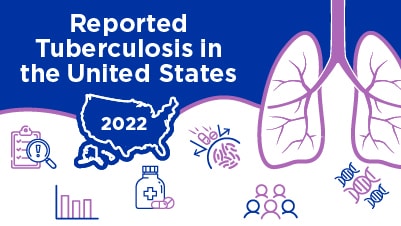
Reported Tuberculosis in the United States, 2022
On November 15, 2023, CDC published Reported Tuberculosis in the United States, 2022. The report describes information on TB disease reported to the CDC since 1993, with an emphasis on TB disease cases counted by reporting areas in 2022, and the ongoing effects of the COVID-19 pandemic on TB disease surveillance.
CRUSH-TB
In November, CDC’s Tuberculosis Trials Consortium (TBTC) launched an international clinical trial, Combination Regimens for Shortening Tuberculosis Treatment, or CRUSH-TB. This exciting new trial aims to identify new combinations of drugs to shorten treatment of TB disease. Learn more below or from a Dear Colleague Letter.
Combination Regimens for Shortening Tuberculosis Treatment (CRUSH-TB)
CDC’s TBTC launched an international clinical trial, Combination Regimens for Shortening Tuberculosis Treatment, or CRUSH-TB, to identify new combinations of drugs to shorten treatment of TB disease. These new regimens may improve drug tolerability and minimize drug interactions, giving healthcare providers more options to treat TB disease and completion of treatment. The trial compares the effectiveness and safety of 4-month bedaquiline, moxifloxacin, and pyrazinamide-based regimens to the standard of care 6-month regimen among patients with drug-susceptible pulmonary TB disease.
CRUSH-TB aims to enroll at least 288 participants from international TBTC sites over the next year. The study will randomly assign participants into one of three different study groups. The participants will know which TB treatment regimen they receive. The adaptive study design allows the researchers to add study groups to the trial to assess new TB treatment regimens. The trial will include a diverse group of participants including, children 12 years of age or older and people with human immunodeficiency virus (HIV).
CDC’s cutting-edge research uses domestic experiences to strengthen global TB elimination efforts and inform new treatment guidelines and recommendations. For CRUSH-TB, TBTC builds on the success of an international phase 3 clinical trial conducted with the National Institutes of Health-sponsored AIDS Clinical Trials Group. The results from that trial informed interim guidance for a 4-month treatment regimen to treat drug-susceptible pulmonary TB disease.
Submitted by Wendy Carr, PhD
New CDC Analysis of U.S. Healthcare Providers’ TB Practices
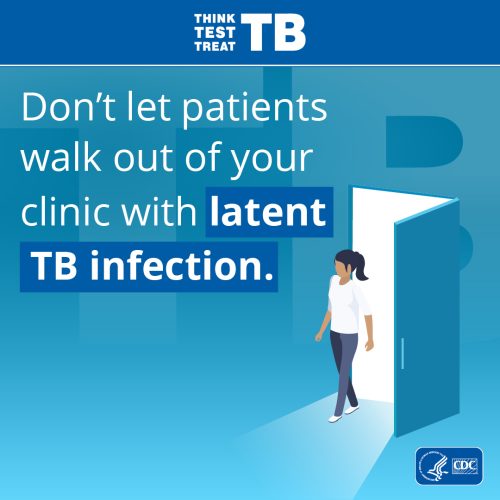
CDC recommends testing persons at increased risk for TB infection as part of routine health care using TB blood tests, when possible, and if a diagnosis of latent TB infection is made, prescribing a short-course treatment regimen to prevent the development of TB disease.
A new CDC publication in Morbidity and Mortality Weekly Report, “Tuberculosis Testing and Latent Tuberculosis Infection Treatment Practices Among Health Care Providers — United States, 2020–2022” shares an analysis of how health care providers are implementing the latest latent TB infection recommendations.
Key findings:
- Among 3,647 health care providers surveyed, approximately one half (53%) reported routinely testing non–U.S.-born patients for TB infection.
- More than one half (59%) reported prescribing any treatment for latent TB infection, but only 33% reported prescribing preferred short-course regimens. In addition, 41% referred patients to a health department for latent TB infection treatment.
- Further efforts are needed to address barriers for health care providers to test for and treat latent TB infection in persons at risk.
Learn how health care providers and patients can work together to think, test, and treat TB.
Submitted by Elise Caruso, MPH

New What You Need to Know About TB Factsheet: Available in 3 Languages
CDC’s Division of TB Elimination is pleased to announce that the new What You Need to Know About Tuberculosis fact sheet is now available in English, Spanish, and Ukrainian. The fact sheet provides basic information about TB transmission, symptoms, testing, and treatment.
The fact sheet can be downloaded from the CDC TB website. Print copies are available to order free of charge on the CDC On Demand website.
Submitted by Coralis Rodriquez Morales, MPH
2021 National Contact Investigation Report
DTBE’s Program Evaluation and Health Economics Team released the 2021 US Contact Investigation Report on October 26, 2023. Contact investigations are used to identify persons exposed to infectious TB disease, assess contacts for infection with M. tuberculosis and TB disease, and provide contacts with treatment for latent TB infection or TB disease. Follow-up examination and treatment of contacts to patients with tuberculosis is a national TB prevention and control priority in the United States.
Each year, TB programs report the results of their contact investigation activities to CDC by entering the data online into the Aggregate Reports for Tuberculosis Program Evaluation (ARPE) form located in the National Tuberculosis Indicators Project (NTIP) performance-monitoring system. ARPE data provide the only national-level data on contact investigations and are reported in three categories:
- Sputum smear-positive,
- Sputum smear-negative/culture-positive, and
- Other.
The 2021 Contact Investigation report summarizes national contact investigation efforts related to TB cases diagnosed in 2021, as well as summary data from the period 2017-2020.
TB programs are encouraged to review their data through the NTIP performance-monitoring system and compare them with the national averages to help evaluate and coordinate TB prevention activities. CDC staff are available to provide technical assistance to those programs interested in designing and implementing strategies to overcome barriers and improve contact investigation performance.
For a copy of the 2021 U.S. Contact Investigation Report, contact the CDC TB Program Evaluation Consultant for your jurisdiction.
Submitted by Tempest Hill, DrPH, MPH
Protecting Mothers and Babies from TB Disease
TB disease among newborns is extremely serious, resulting in death in half of all cases. CDC’s Morbidity and Mortality Weekly Report (MMWR) recently published the story of TB disease in a mother who underwent in vitro fertilization (IVF) and the death of her newborn in the United States. The report identifies overlooked risk factors and missed opportunities for life-saving TB testing and treatment. The death might have been avoided with TB diagnosis and treatment during the infertility evaluation or during pregnancy.
Prenatal care clinicians and fertility specialists should consider TB evaluations for people with TB risk factors, including being born in countries where TB disease is common, especially when symptoms are present.
Submitted by Neela Goswami, MD, MPH
Dr. Mindy Dunn Receives CDC Laboratory Excellence Award

The CDC/ATSDR Office of Laboratory Science and Safety (OLSS), Office of Laboratory Safety selected Melinda (Mindy) Dunn, PhD to receive the CDC Laboratory Excellence Award, ‘Laboratory Safety Star Award’ for September 2023. This award recognizes a CDC/ATSDR employee who promotes laboratory safety and best practices.
Dr. Dunn is the Safety Officer for the Laboratory Branch (LB) in the DTBE. As the Branch Safety Officer, Dr. Dunn leads multiple safety initiatives for both the biosafety level 2 (BSL-2) and biosafety level 3 (BSL-3) laboratories and ensures safe laboratory practices.
Recognizing constraints for responding to a medical emergency within the BSL-3 laboratory and the need for training on safety protocols for staff, Dr. Dunn developed and led in-person trainings for her colleagues earlier this year. During the trainings, Dr. Dunn detailed the signs and symptoms of heart attack, stroke, and cardiac arrest, discussed steps in responding to an emergency, demonstrated evacuation procedures, and led hands-on exercises including how to use an automated external defibrillator (AED) and placing an incapacitated person onto a patient carry tarp. By providing these exercises, participants were able to practice how they would respond in different emergency scenarios.
Additionally, Dr. Dunn created an acronym, DEPART, to help her colleagues remember essential steps in addressing a medical emergency and safely removing staff from a laboratory. DEPART stands for designate others to help, gather emergency equipment, don PPE, assess surroundings, check for respiration, and transport victim.
Following the training, staff indicated an increased level of comfort if an emergency event were to occur in the laboratory. Dr. Dunn’s efforts have made LB safer, and she is highly deserving of this recognition. Congratulations Dr. Mindy Dunn!
Submitted by Monica Youngblood, MPH, M(ASCP)
Reported Tuberculosis in the United States, 2022 Now Available
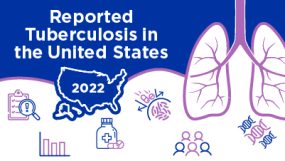
CDC published provisional tuberculosis (TB) data in CDC’s Morbidity and Mortality Weekly Report. The full report, Reported Tuberculosis in the United States, 2022, is now available exclusively online.
The report describes information on TB disease reported to the CDC since 1993. This year’s report emphasizes TB disease cases counted by reporting areas in 2022 and the ongoing effects of the COVID-19 pandemic on TB disease surveillance.
Key Highlights:
- The reported number of TB cases in the United States increased from 7,870 TB cases in 2021 to 8,331 TB cases in 2022, a 5.9% increase.
- The national TB incidence rate increased from 2.4 cases per 100,000 persons in 2021 to 2.5 cases per 100,000 persons in 2022. Eight states reported incidence rates higher than the national incidence rate.
- As in past years, cases of TB disease were not evenly distributed across the United States. Four states account for half of all reported U.S. TB cases: California, Texas, New York (including New York City), and Florida.
- Consistent with previous years, TB disease disproportionately affected people from racial and ethnic minority groups and non-U.S.–born persons in the United States.
Before the COVID-19 pandemic, TB case counts and incidence rates had been steadily decreasing in the United States since 1992. However, TB case counts and incidence rates declined sharply during the COVID-19 pandemic. In 2022, reported TB cases and incidence rates in the United States increased for the second year in a row, but remained lower than levels reported prior to the COVID-19 pandemic. The number of reported TB cases and incidence rates appears to be gradually returning to prepandemic levels but concerns about pandemic-related disruptions to public health persist.
Ending TB will require a dual approach of maintaining and strengthening efforts to diagnose and treat TB disease and latent TB infection, especially in populations at increased risk for TB disease.
CDC created a slide set and infographic to highlight findings from the 2022 surveillance report.
Submitted by Pei-Jean Feng, MPH
TB Epidemiologic Studies Consortium (TBESC-III) Annual Meeting

On October 25-26, 2023, TBESC hosted an Annual Meeting for involved individuals. Topics discussed during the Annual Meeting included discussions after the first year of implementing interventions, education and training, and planned analyses and manuscripts. Attendees were also able to network and learn best practices from colleagues.
Submitted by Divia Forbes, MPH
Tuberculosis Elimination Alliance Hosts Virtual Summit

The Tuberculosis Elimination Alliance (TEA) hosted the 2023 TEA virtual summit on November 8-9, 2023. This year’s summit focused on the theme “Building Healthy Communities Free of TB,” showcased TEA’s Mini-Grant Program and the remarkable innovations from diverse communities and their collaborative efforts towards achieving health equity over the past five years.
Over the span of two days, participants heard discussions on lessons learned and promising practices from communities on the impact of TEA’s mini-grants. For more information, visit the TEA website.
Caruso E, Mangan JM, Maiuri A, Bouwkamp B, DeLuca N. Tuberculosis testing and latent tuberculosis infection treatment practices among health care providers−United States, 2020−2022. MMWR Morb Mortal Wkly Rep 2023;72:1183−1189.
Vonnahme LA, Raykin J, Jones M, Oakley J, Puro J, Langer A, Aiona K, Belknap R, Ayers T, Todd J, Winglee K. Using electronic health record data to measure the latent tuberculosis infection care cascade in safety-net primary care clinics. AJPM Focus. 2023 Sep 28.
Dawson-Hahn E, Fredkove W, Karim S, Mohamed F, Abudiab S, de Acosta D, Ebengho S, Garcia Y, Hoffman S, Keaveney M, Mann E, Thomas C, Yu K, Yun K. Perspectives of public health organizations partnering with refugee, immigrant, and migrant communities for comprehensive COVID-19 case investigation and contact tracing. Front Public Health. 2023 Sep 5;11:1218306.
Marshall KE, Free RJ, Filardo TD, Schwartz NG, Hernandez-Romieu AC, Thacker TC, Lehman KA, Annambhotla P, Dupree PB, Glowicz JB, Scarpita AM, Brubaker SA, Czaja CA, Basavaraju SV. Incomplete tissue product tracing during an investigation of a tissue-derived tuberculosis outbreak. Am J Transplant. 2023 Sep 15:S1600-6135(23)00693-7.
Winters N, Schnitzer ME, Campbell JR, Ripley S, Winston C, Savic R, Ahmad N, Bisson G, Dheda K, Esmail A, Gegia M, Monedero I, Dalcolmo MP, Rodrigues D, Singla R, Yim JJ, Menzies D. Identifying patients with multidrug-resistant tuberculosis who may benefit from shorter durations of treatment. PLoS One. 2023 Oct 5;18(10):e0292106.
Cash McGinley HL, Hancock WT, Kern-Allely S, Jenssen M, Chutaro E, Camacho J, Judicpa P, Okumura K, Muñoz N, Ademokun OM, Brostrom R. COVID-19 in the US-affiliated Pacific Islands: A timeline of events and lessons learned from March 2020-November 2022. PLOS Glob Public Health. 2023 Aug 16;3(8):e0002052.
Groenweghe E, Swensson L, Winans KD, Griffin P, Haddad MB, Brostrom RJ, Tuckey D, Lam CK, Armitige LY, Seaworth BJ, Corriveau EA. Outbreak of Multidrug-Resistant Tuberculosis — Kansas, 2021–2022. MMWR Morb Mortal Wkly Rep 2023; 72:957-960.
Swartwood NA, Testa C, Cohen T, Marks SM, Hill AN, Beeler Asay G, Cochran J, Cranston K, Randall LM, Tibbs A, Horsburgh CR Jr, Salomon JA, Menzies NA. Tabby2: a user-friendly web tool for forecasting state-level TB outcomes in the United States. BMC Med. 2023 Aug 30;21(1):331.
To receive the TB Notes Newsletter, enter your email address at the bottom of the TB Notes webpage. If you would like to submit an article or update in TB Notes, please email Kevin Crooks at qyd7@cdc.gov.
You can follow us on Twitter @CDC_TB and Facebook @CDCTB and sign up for email updates through Adobe Campaign.
